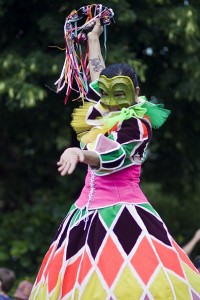
As the countdown to leaving ECLA—and for most of us, Berlin—is left with a zero in front of the month units, everyone is trying to use the remaining days, hours and minutes to cross off as many “to do and visit while in Berlin” entries that might have been postponed during the cold winter months.
Luckily, May weather has, for the most part, been favorable to this ordeal and the unusually high number of public holidays has helped counter the Spring Term academic workload and leave greater space for activities outside our everyday scholarly environment.
These two ingredients manifested themselves in the proliferation of both spontaneous trips to the numerous parks and lakes around Berlin, and parades, fairs and other open-air concerts and celebrations, organized annually and traditionally anticipated by local Berliners, always keen to share their enthusiasm about them with newcomers to their breathtaking city.
The ambitious promise that the 1st of May manifestations carried was not only kept, but raised to new heights by the end of the month, by the long weekend “Karneval der Kulturen” in the ever-vibrant district of Kreuzberg. It managed to sum up Berlin life to an extent that would suffice in providing any one-day visitor or tourist with a decently abridging glimpse of this city’s year-round spirit.
Not that the procession of more than 100 trucks and vans blasting music from the most diverse (sometimes unheard of) parts of the world danced to by people dressed in national garments in the wildest combinations of colors and materials, happens every day, to avoid such a misunderstanding.
The aspect of Berlin that this carnival zooms in on and encapsulates, with its display of decadence and hedonism in food, music and dance, is, as its name suggests, the celebration of multiculturalism as one of the most distinctive traits of the city.
But far be it from calling Berlin the only or the most multicultural city in Europe. The reason it deserves its own commemorative carnival more than any other metropolis is the way the multicultural spirit is implemented and experienced. Different cultures in Berlin are not only accepted and to a certain extent admired, but fully embraced and integrated in the urban myth, constantly updated as its demographic structure changes from year to year.
Staying true to their youthful and metropolitan spirit, Berliners exemplified this unique openness to the world in the 7-digit number of visitors at this year’s Karnival der Kulturen, all almost randomly dispersed amongst the stands of food, handicrafts and drinks from every imaginable place in the world, or trailing behind and mimicking the dances of the carnival participants on the Sunday of the Pentecost’s procession down Yorkstrasse.
It was precisely this unique opportunity to partake in the procession alongside participants displaying their cultural diversity, but also with those experienced enough to keep up with them, that set aside Berlin’s carnival from parades elsewhere in Europe.
The image of a South African and an Indian enthusiastically attempting to keep up with the diametrically diverse sounds and dances of Ghana, Puerto Rico and the Balkans, was hardly an exceptional one, as it seemed as if everyone was there to move as far from their comfort zone as possible with the intention of discovering and falling in love with a new aspect of the assortment of ideas that Berlin offers every day.
The end of the carnival and the return to every-day life went smoother than expected, given the aforementioned similarities between the two. For an ECLA student, it shouldn’t come as a surprise—the past 8 months themselves have been comparable to a carnival of cultures, an exchange between 60 personalities even more diverse than the geographically dispersed home countries they came to Berlin from.
As this micro-carnival in Pankow enters its final month, any melodramatic or nostalgic reminiscing should be put off until graduation day, before which there are just enough days to explore the city no one could’ve avoided falling in love with.
Blagojce Nestorov (AY’12, Macedonia)
